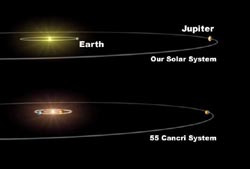
Farmers growing corn in the mid-Atlantic region will have a new tool to help them identify appropriate cultural practices for the types of soils in their fields, thanks to research conducted by researchers from Virginia Tech and Colorado State University.
“Soils vary in their ability to hold water,” said Mark Alley, professor of crop and soil environmental sciences at Virginia Tech. “If a farmer knows the water-use efficiency of the soils in his field, he has a very important clue on how to mana

After 15 years of observation and a lot of patience, the world’s premier planet-hunting team has found a planetary system that reminds them of our home solar system.
Geoffrey Marcy, astronomy professor at the University of California, Berkeley, and astronomer Paul Butler of the Carnegie Institution of Washington, D.C., today announced the discovery of a Jupiter-like planet orbiting a Sun-like star at nearly the same distance as the Jovian system orbits our sun.
“All other extr

Violence, bereavement, debt and other stressful experiences do not increase the chances of breast cancer returning in a woman who has been treated for the disease.
The good news was announced today in a new study by Europe`s largest cancer charity, Cancer Research UK, and published in the British Medical Journal.
The study, headed by Professor Amanda Ramirez at Cancer Research UK`s London Psychosocial Group, looked at more than 200 women with operable breast cancer and followed thei

Durham University scientists have successfully carried out a basic computer operation using a magnetic microchip – a major step along the way to establishing a new generation of electronics and computer technology.
They are working in the rapidly growing field of nanotechnology, harnessing the magnetic properties of electrons, rather than their electrical charge on which conventional electronics is based. Magnetic microchips could, in the future, offer a range of benefits over standard chips

Pregnancy prevention programmes for adolescents do not delay sexual intercourse, improve use of birth control among young men and women, or reduce the number of pregnancies in young women, finds a study in this week’s BMJ.
Researchers in Canada reviewed 26 trials of adolescents (aged 11 to 18 years) that evaluated pregnancy prevention programmes including sex education classes, abstinence programmes, family planning clinics, and community based programmes.
The prevention strategies

Rare images of the Himalayan snow leopard in its natural habitat are expected to help improve the survival chances of the world’s elusive and little-known fifth-largest big cat. A research expedition backed by the Royal Geographical Society (with IBG) used remote camera technology to record some of the first-ever photos of this endangered animal’s behaviour in the wild.
The innovative experiment, high in the Indian Trans-Himalaya, is encouraging for snow leopard conservation and demonstrates

– new calculation confirms standard model of particle physics. Contribution of hadronic vacuum polarization determined with unprecedented accuracy. The magnetic moment of the muon is an important precision parameter for…
Technique may prevent formation of unwanted waves that siphon off needed energy. Heating plasma to the ultra-high temperatures needed for fusion reactions requires more than turning the dial on a…

An international team of astronomers, led by researchers from the Astronomical Observatory of the University of Warsaw, have identified a new class of cosmic X-ray sources. The findings have been…

How deubiquitinases USP53 and USP54 cleave long polyubiquitin chains and how the former is linked to liver disease in children. Deubiquitinases (DUBs) are enzymes used by cells to trim protein…

Conceptual blueprint to analyze experimental catalyst data. Machine learning (ML) models have recently become popular in the field of heterogeneous catalyst design. The inherent complexity of the interactions between catalyst…

Antibody that Neutralizes Inhibitory Factors Involved in Nerve Regeneration Leads to Enhanced Motor Function after Acute Spinal Cord Injury. Researchers at 13 clinics in Germany, Switzerland, the Czech Republic and…

How simulations help manufacturing of modern displays. Modern materials must be recyclable and sustainable. Consumer electronics is no exception, with organic light-emitting diodes (OLEDs) taking over modern televisions and portable…

“Neurons that fire together, wire together” describes the neural plasticity seen in human brains, but neurons grown in a dish don’t seem to follow these rules. Neurons that are cultured…

The quest for sustainable energy solutions has been a major focus of scientific research for decades. Solar energy, a clean and renewable source, has emerged as a promising alternative to…

With a processing speed a billion times faster than nature, chip-based laser neuron could help advance AI tasks such as pattern recognition and sequence prediction. Researchers have developed a laser-based…

New technology could remotely identify various types of plastics, offering a valuable tool for future monitoring and analysis of oceanic plastic pollution. Researchers have developed a new hyperspectral Raman imaging…

Artificial Intelligence (AI) has established a strong presence across industries, large and small. The “VoBaKI” research project has empowered small and medium-sized enterprises (SMEs) with an innovative tool to independently…